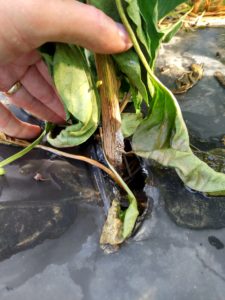Southern blight of pepper and tomato thrives under hot, dry conditions. Usually, such conditions are more likely in August. Production under tunnels may contribute to the dry conditions that influences southern blight. This article will discuss the symptoms, biology and management of southern blight of tomato.
Southern blight has a wide host range affecting many vegetable, field and ornamental crops. Tomato is the most important host. The disease is caused by the fungus Sclerotium rolfsii. This fungus is related to the one that causes white mold.The first symptom one is likely to observe of southern blight is plant wilt. At the base of the plant, one is likely to notice a canker with sclerotia that may be as large as a sesame seed (Figure 1). These sclerotia are survival structures for the fungus and allow the disease to occur in the same location years later. The sclerotia for southern blight are round, about the size of a sesame seed and usually occur near the base of the plant. Sclerotia of white mold are irregular in shape, are pea-size and may occur several feet up the plant. The fungus that causes southern blight also lives off of organic matter without being parasitic (saprophytic).

Figure 1. Southern blight canker at the base of a pepper plant. Tomatoes can also be affected by this disease.
Control of this disease can be difficult. The best crops for rotation are grass plants such as corn and small grains. Deep plowing the residue may help reduce the severity of the disease. Fungicides are not available to manage this disease. The use of high calcium levels and ammonium type fertilizers has been reported to help in management.